The total number of warships being built in Scottish shipyards between 2015 to 2035 now stands at 24, with many of those ships now being built and some already in service.
In addition to the now-built 5 Offshore Patrol Vessels, there are plans for 8 Type 26 Frigates, 5 Type 31 Frigates, 5 Type 32 Frigates, and 1 Ukrainian warship to be built in Scotland.
This article is a fact checking article, if you believe we’ve made an error you can submit a correction in line with our correction policy.
Click the below table to enlarge it.
A Ukrainian warship?
Ukraine previously signed a memorandum with the UK to secure £1.25 billion in funding to build new military vessels for the Ukrainian Navy, the first ship will be constructed in the UK and the remaining 7 vessels will be built in Ukraine.
Type 32?
The new Type 32 Frigate will be built in addition to the Type 26 and Type 31 Frigates in the hopes of bringing the escort fleet up to 24 vessels from its current 19. The Defence Secretary had previously confirmed that Rosyth will be building more vessels than previously planned, with the Type 32 Frigate going into built at the yard after the Type 31 Frigate build finishes.
Ben Wallace, the Defence Secretary, stated that Rosyth would be building Type 32 Frigates in addition to Type 31 Frigates.
“We are committed to building the Type 26 in the United Kingdom; it is under construction on the Clyde. In Rosyth, work is ongoing to build the facility needed to build the Type 31s and the subsequent Type 32s. He also knows that I recently recategorised the future Fleet Solid Support ship as a warship. I intend to make sure that, if not entirely, there is a considerable degree of UK build in that process, subject to tender. I have to be cautious about the contract, because the competition is to begin soon—very soon.”
Of course, this was soon retracted and either the Clyde or Rosyth could get this work.
According to the recently released ‘Defence Command Paper’, the Type 32 frigates will be designed to protect territorial waters, to provide persistent presence overseas and to support Littoral Response Groups.
The first mention of a new Type 32 frigate came in the Prime Minister’s 19 November statement. He said: “We are going to develop the next generation of warships, including multi-role research vessels and Type 32 frigates.”
The Defence Command Paper, titled ‘Defence in a Competitive Age’, describes the planned programme:
“Type 32 frigates, designed to protect territorial waters, provide persistent presence overseas and support our Littoral Response Groups.”
Military shipbuilding in Scotland is going full steam ahead – here’s a brief look at what’s happening.
The following is a copy of the written evidence I submitted to Parliament’s Scottish Affairs Committee Inquiry into Military Shipbuilding in Scotland.
The UK Defence Journal is a Glasgow-based defence industry news and analysis website written by volunteers drawn from a range of defence and industry-related backgrounds and professions. With regards to shipbuilding in Scotland, we have spent many years documenting what’s going in in the industry as well as extensively covering its ups and down in addition to speaking directly to senior industry officials, shipbuilders and others involved in the effort to build ships in Scotland.
Recently I was lucky enough to step onboard HMS Glasgow, the first Type 26 to be built in Glasgow, where I was given a detailed update of the programme and the progress of the ship herself.
The main points raised in this submission, in response to the specific questions asked, are:
- The National Shipbuilding Strategy and the move away from one supplier of complex warships (BAE at Govan) to a more distributed approach has resulted in a second shipyard in Scotland (Babcock at Rosyth) entering the business of military shipbuilding.
- Scottish shipyards will be building the bulk (if not all) of the Royal Navy escort fleet over the coming decades resulting in significant growth to the sector.
- The ‘case by case’ procurement approach has helped the industry avoid the risk of encountering a ‘feast and famine’ order scenario once more.
- Export orders benefit the supply chain here in Scotland immensely as, for example, overseas orders for Type 26 Frigate derived vessels potentially allows industry here to supply components for thirty-two ships instead of just eight.
- Investment in better infrastructure, such as covered build halls, would help increase the attractiveness and efficiency of military shipbuilding in Scotland.
What impacts are the Government’s Shipbuilding Strategy and National Shipbuilding Office having on the shipbuilding industry in Scotland?
Even just ten years ago shipbuilding in Scotland was described as a ‘feast and famine’ industry [1] with effectively one or two shipyards hiring large numbers of new staff to work on a small number of new ships. This would then be followed by the ‘famine’ stage, with layoffs and uncertainty over whether-or-not there will be any future orders and whether-or-not the yard would have to close[2].
Now, I believe, the industry is facing a much-improved situation. Shipbuilding in Scotland is, primarily, structured to be able to meet the capability demands of the Royal Navy. However, the National Shipbuilding Strategy aimed to encourage the shipbuilding side of the defence industry to reduce its dependence on the Ministry of Defence as a sole customer and concentrate effort in securing a wider potential share of the international market.
With the success of the Type 26 and Type 31 designs in the export market, this aim of reducing dependence on the Ministry of Defence is being achieved to a small degree.
Additionally, another aim of the National Shipbuilding Strategy was to reduce reliance of the Ministry of Defence on one provider for the UK’s surface warships[3], namely BAE currently building the Type 26 Frigate and eventually, it is expected, the Type 83 Destroyer. This shift in strategy has allowed Babcock at Rosyth to enter the business of complex warship construction in Scotland with the Type 31 Frigate and to sustain this down the line with the planned Type 32 Frigate[4].
There is now a steady ‘drumbeat’ of orders at two shipyards and plans for future classes are well known in industry. This allows for certainty, the retention of skills and greater investment[5]. All of this contributes to bring down the cost of the vessels in the longer term. In short, there’s now more work for more people at more yards than in previous decades. The UK Government also recently launched a refreshed National Shipbuilding Strategy (NSbS) to “revitalise” the UK’s shipbuilding industry.
The strategy, they claim, will deliver a pipeline of more than 150 new naval and civil vessels for the UK Government and for the Devolved Administrations over the next 30 years. The military vessels outlined in the plan include the following ‘big ticket’ items, the Type 26 Frigates, the Type 31 Frigates, the Type 32 Frigates, the Multi Role Support Ships, the Fleet Solid Support Ships, the future Auxiliary Oilers, an Ice Patrol Ship and the Future Offshore Patrol Vessels. There are also a range of smaller support craft planned[6].
Not all of these vessels will be built in Scotland, but Scottish industry could potentially benefit from taking part, in varying degrees, in the work. I have however highlighted the vessels that are likely to be built in Scotland in the next section.
How many and what types of Royal Navy ships will likely be built in Scotland in the years ahead? Will the sector grow?
In short, the shipyards have work or are planning for work up to the 2040s. This work is primarily focused in Glasgow and in Rosyth and is almost entirely Royal Navy warships. One Ukrainian warship was also planned for Rosyth[7].
It is expected that the second batch of Type 26 Frigates will be confirmed soon as long-lead items have already been ordered[8].
I have included the Type 32 Frigate in the below chart after remarks from the Secretary of State for Defence Ben Wallace stating, “In Rosyth, work is ongoing to build the facility needed to build the Type 31s and the subsequent Type 32s”[9], this is amid speculation that the vessel will be a follow-on product related to the Type 31 vessels being built at Rosyth.
Ben Wallace, the Defence Secretary, stated that Rosyth would be building Type 32 Frigates in addition to Type 31 Frigates.
“We are committed to building the Type 26 in the United Kingdom; it is under construction on the Clyde. In Rosyth, work is ongoing to build the facility needed to build the Type 31s and the subsequent Type 32s. He also knows that I recently recategorised the future Fleet Solid Support ship as a warship. I intend to make sure that, if not entirely, there is a considerable degree of UK build in that process, subject to tender. I have to be cautious about the contract, because the competition is to begin soon—very soon.”
Of course, this was soon retracted as he claimed to have misspoke, now either the Clyde or Rosyth could get this work.
Type 83 has also been included as, in my discussions with industry, I have been made aware that BAE Systems on the Clyde is the expected location for these to be built due to an “aspiration is to achieve continuous shipbuilding in Glasgow beyond the current planned number of eight vessels”[10].
| Name | Class | Location | Launch Period |
| HMS Glasgow | Type 26 (Batch 1) | Glasgow | 2020s |
| HMS Cardiff | Type 26 (Batch 1) | Glasgow | 2020s |
| HMS Belfast | Type 26 (Batch 1) | Glasgow | 2020s |
| HMS Birmingham | Type 26 (Batch 2) | Glasgow | 2020s |
| HMS Sheffield | Type 26 (Batch 2) | Glasgow | 2020s |
| HMS Newcastle | Type 26 (Batch 2) | Glasgow | 2020s |
| HMS Edinburgh | Type 26 (Batch 2) | Glasgow | 2030s |
| HMS London | Type 26 (Batch 2) | Glasgow | 2030s |
| HMS Venturer | Type 31 | Rosyth | 2020s |
| HMS Bulldog | Type 31 | Rosyth | 2020s |
| HMS Campbeltown | Type 31 | Rosyth | 2020s |
| HMS Formidable | Type 31 | Rosyth | 2020s |
| HMS Active | Type 31 | Rosyth | 2020s |
| UNKNOWN | Ukrainian Warship | Rosyth | UNCERTAIN* |
| Unknown | Type 32 | Rosyth | 2020s |
| Unknown | Type 32 | Rosyth | 2030s |
| Unknown | Type 32 | Rosyth | 2030s |
| Unknown | Type 32 | Rosyth | 2030s |
| Unknown | Type 32 | Rosyth | 2030s |
| Unknown | Type 83** | Glasgow | 2030s |
| Unknown | Type 83 | Glasgow | 2030s |
| Unknown | Type 83 | Glasgow | 2030s |
| Unknown | Type 83 | Glasgow | 2030s |
| Unknown | Type 83 | Glasgow | 2030s |
| Unknown | Type 83 | Glasgow | 2040s |
*The status of the plan to order a warship for Ukrainian is unknown due to the ongoing invasion of the country. **Additionally, the listing of six Type 83 Destroyers presumes the Type 45 Destroyers are replaced on a one for one basis.
With regards to growth expected in the sector, it is important to note that according to the Ministry of Defence, due to increased regional expenditure in the Shipbuilding and Repairing industry, Scotland and the Northwest of England now account for 62% of all MOD supported employment in the shipbuilding sector with the bulk of that present in Scotland[11].
The document states that the rise in direct jobs supported from MOD expenditure in Scotland since 2018/19 was 22%. This rise is attributed to “increased expenditure on Construction and Shipbuilding in Scotland helped to boost total direct jobs supported in the region in 2019/20”.
In 2019/20, £3.8 billion was spent in the UK-wide shipbuilding industry which supported 27,100 direct jobs in the same industry group and a further 19,400 indirect jobs across all industry sectors, this effectively means that every 3 jobs in shipbuilding and repair are generating 2 indirect jobs elsewhere[12].
It is my belief, based on the data, that with the continued and steady drumbeat of work the sector will grow not only in direct jobs but also indirect jobs as demonstrated by the figures above.
How does the procurement approach for each class of Royal Navy ship being determined on a case-by-case basis (including whether there should be international competition) affect Scottish shipbuilding?
It is hard to see any other realistic alternative to ordering ships on a case-by-case basis given that warships are effectively products designed and built by private companies. Ships being awarded on a case-by-case basis encourages competition, innovation and (in theory) the driving down of costs.
The only other alternative to this approach, in my view, would be having yards set up to build specific types of ships, frigates, destroyers etc. However, having one yard guaranteed the work to build destroyers and another guaranteed the work on frigates then the industry runs the risk of encountering a ‘feast and famine’ scenario once more. Once the frigates are built, what next?
Quite simply, the Royal Navy does not require the volume of ships required to make that approach sustainable in the long term, it runs the risk of yards sitting empty and idle whilst waiting for the next class of ship. We’ve seen this issue at Barrow, a BAE Systems yard now solely devoted to the construction of Astute class submarines and Dreadnought class submarines. Gaps between the design of Vanguard and Astute submarines lead to the departure of highly skilled and experienced personnel to other industries[13].
It is my view that the UK was only able to re-establish a viable submarine construction industry after that gap due to the assistance of the US submarine building firm company, General Dynamics Electric Boat [14].
In Evidence given to the Defence Committee on this topic previously, industry representatives suggested that there was a minimum frequency of production that was essential if the UK was to retain a viable submarine industry, this applies to surface vessels too of course. In other evidence to the Defence Committee, Rolls-Royce stated that the gap between Vanguard and Astute led to the number of manufacturers of a specific, required component fell from five to two, again this would be a concern for surface shipbuilding.
It is my belief that should any serious gap appear once more between the building of ships at a location, the loss of capability is likely to be irreversible and would have catastrophic impact on the capability of shipyards in Scotland to build warships. In summary, a case-by-case approach makes the best use of any available capacity at the yards, it makes the best use of the workforce, and it allows for a competitive approach to ordering ships and in my view is the reason that shipbuilding in Scotland is no longer a ‘feast or famine’ industry.
With regards to international competition, the UK Government have previously stated that they do not order ships like frigates or destroyers internationally. In fact, the previous iteration of the National Shipbuilding Strategy stated[15]:
“For reasons of national security, all Royal Navy warships (destroyers, frigates and aircraft carriers) will continue to have a UK-owned design, and, will be built and integrated in the UK. Warship build will be via competition between UK shipyards. But international partners will be encouraged to work with UK shipyards and other providers to produce the best possible commercial solution.[16]”
However, the recently released ‘refreshed National Shipbuilding Strategy’ states that decisions on procurement for each type of Royal Navy ship will be determined on a case-by-case basis, appearing to open up the potential situation of a foreign shipyard building a Royal Navy frigate or destroyer. The document states:
“As well as considering the specific capability requirements, the MoD will consider the long-term industrial impact of different options, including delivering value for money for the overall programme and maintaining the key industrial capabilities required for operational independence[17]“.
It is the view of many in industry that I have spoken to however that the Ministry of Defence, for reasons outlined above, would prefer Royal Navy warships to be built in the United Kingdom in their entirety but this new approach recognises that some key parts of projects or specific components may need to be outsourced overseas.
To what extent does Scotland benefit from exporting military ships (or parts of them) and/or their design licences? How can these opportunities be maximised?
While, for example, the Type 26 Frigate based vessels ordered by Australia and Canada will not be built on the Clyde it is important to remember that there is still a benefit not only in reduced unit costs in the longer term but there is also a benefit to companies around Scotland and the wider UK making components for these vessels. Export success is also important to the Ministry of Defence; competitive companies, winning export work, enable overheads to be spread, reducing the unit cost to the Department.
In short, I’m getting at the idea that a company only building eight components for the British Type 26 fleet could now be building up to thirty-two components for the British, Canadian and Australian fleets. Export orders benefit the supply chain here in Scotland immensely.
The exports have turned the Type 26 Frigate from an eight-ship class to, essentially, a thirty-two ship class [18].
While it is fair to say that there will be significant local supply chain involvement in Canada and Australia, it should be noted that the businesses based in Scotland will have the advantage of retaining intellectual property and the fully trained people, putting them in prime position to compete for the work, even overseas. In addition, the export of ships and their components is beneficial for the cost related to maintenance and supply lines when it comes to operating the finished vessels.
What I mean by that is that the increased number of units, be they ships or components of ships, in service with navies worldwide makes it far more economical for the company building the components to retain repair and refurbishment facilities for those components here in Scotland, sustaining jobs and sustaining the ability of naval forces to cost effectively repair or replace those components should the need arise.
What more could the UK Government do to maintain and foster military shipbuilding in Scotland?
As things stand, the UK Government is, by far, the primary customer for the shipbuilding industry in Scotland. The entire future surface fleet of frigates and destroyers are, it’s expected, to be built in Scottish shipyards. Outside of procurement however there are, I believe, areas in which the UK Government could invest in order to encourage growth in the industry.
When writing this submission, I stated that I believed that investment allowing for a fully covered build hall (such as the one built in Rosyth) will encourage a faster and therefore cheaper procurement of larger warships.
Well, that happened. BAE’s Govan shipyard is expanding. The facility will allow huge Type 26 frigates to be built entirely indoors – partly thanks to public funding.
BAE hopes to construct the next batch of five Type 26 frigates, bringing the total built up to eight, inside the purpose-built facility. As things stand today, the first three ships are being built inside a much smaller shipbuilding hall in sections before being moved outside and welded together. It works, but it’s not very efficient and exposes the insides of complex vessels to the elements.
As mentioned above, this effort to enhance the capacity of the yard will proceed with some public funding. At a recent meeting of the Defence Committee, Defence Secretary Ben Wallace revealed that the Ministry of Defence (MOD) is investing in the BAE shipyard to increase its capacity and productivity for future work. Wallace told the committee, “I am delighted that BAE is going to put a covered build hall in place. We will be contributing to it as the MoD and the customer, but that is the sort of thing that is about the cultural shift and investing in the yard, so that when, whatever happens one day – there is not a naval contract or it wins another contract to build a civil ship – it can show that productivity”.
Glasgow shipyard expanding – public funding helps secure new ‘frigate factory’
Currently in Glasgow, warships are built indoors in sections and moved out onto the ‘hard standing’ to be assembled in the open[19], requiring significant weather proofing and allowing for relatively sensitive kit becoming exposed to the elements or prying eyes.
In Rosyth, Babcock have completed the ‘Venturer building’, a large, covered build hall which will house two frigates for uninterrupted, parallel assembly and, say Babcock, “support increased productivity gains through improved access to the platforms and digital connectivity”[20].
The Rosyth facility contains modern manufacturing facilities and new digital systems as well as gantry access to remove the need for scaffolding. Glasgow will soon have that luxury too.


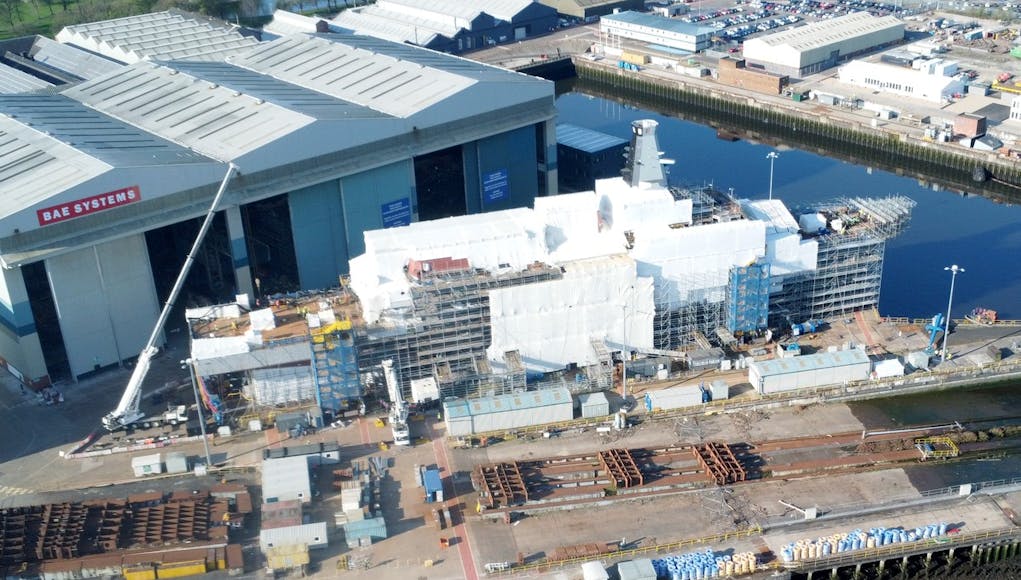
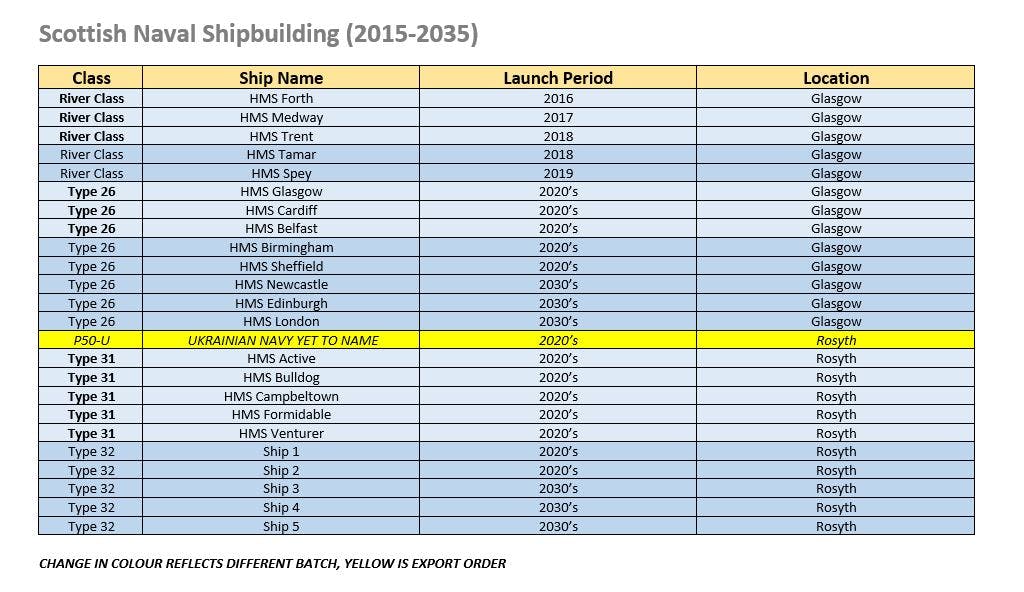


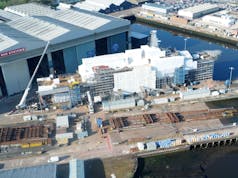

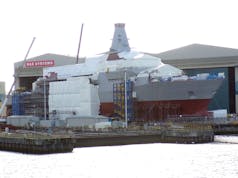


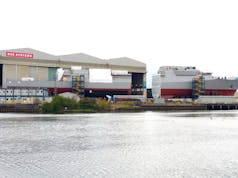


When will the Type 45 destroyer replacement be built? I thought it was around 2030 but there are no slots for it. I assume there will be a competition to see who is to build it.
There will be a Scottish nationalist along on Twitter shortly to tell you you’re wrong.